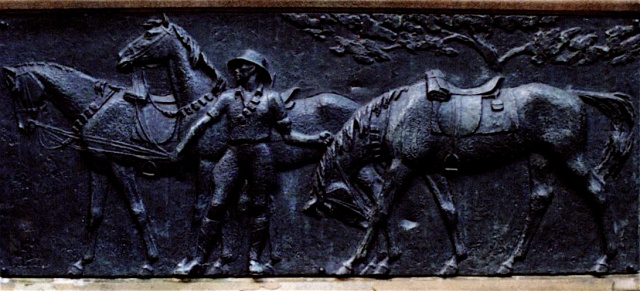Market Day
Two or three Sundays every month I take a bookstall at the Old Bus Depot Market here in Canberra. It's one of the country's award-winning indoor arts and crafts markets – certainly a good place for a writer to meet readers, compare notes, sell a few books ... and incidentally gather ideas for present and future scribblings.
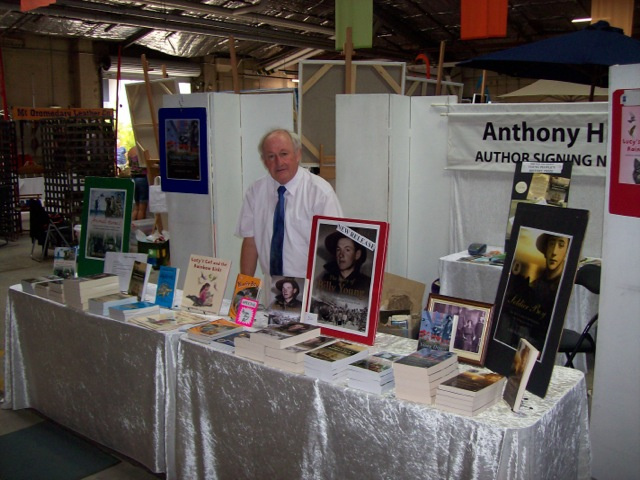
A few weeks ago a woman from northern New South Wales was browsing through the military books and chatting, when she remarked that she'd started breeding Walers again on her property. Several country people have said the same, and I think it’s a marvellous venture.
But this time I really pricked up my ears, as it were, for I was up to that part with the current work and writing about these splendid horses once more. How was she going? How were the foals turning out?
Pretty well, it seems. And it's hard to go too far wrong, for the Walers are not so much a specific breed of horse but rather a kind. Their virtues come only in part from their breeding – the rest is all character, as I'd discovered during the writing of Animal Heroes.
Walers
Henry Gullett wrote the volume describing the Light Horse desert campaign in the Official History series of Australia in the Great War. He's sometimes been criticised for romanticising somewhat the horsemen: but on the subject of their mounts he was spot on. Essentially they were Australian and New Zealand stock horses, with just that little bit of something else.
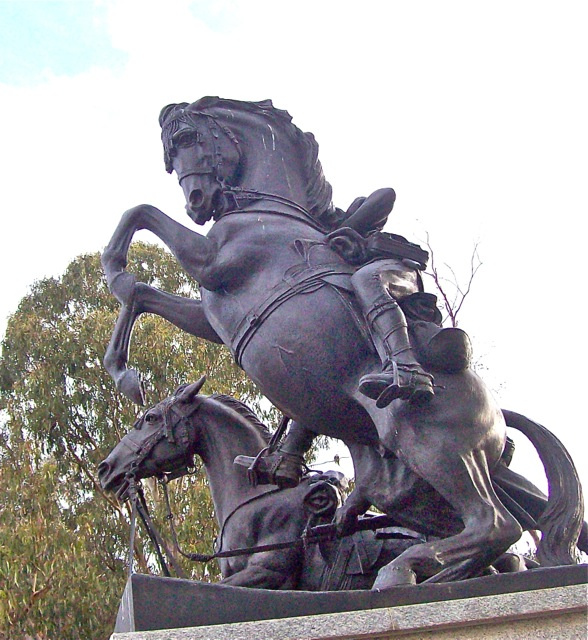
Australian and New Zealand Light Horse Memorial, replica.
They came in a variety of shapes and sizes, standing anything from 14 to 16 hands high, for their dams were all types ... Welsh ponies, three-quarter horses, brumbies from the bush, Timor ponies, draught horses. In fact the best always had some shire horse in them.
The other thing they had in common was that their sires were nearly all descended from English thoroughbred racing stock; and as Gullett observes, the closer to the thoroughbred the better.
This quality, reflected throughout in their spirit and stamina, was the distinguishing characteristic.
Nobility
You can see it online with the photographs in the collections at the Australian War Memorial(search ‘Walers’ or ‘Light Horse’).
And you can also find it in a beautiful bronze sculptured head – the very head itself – of Sandy, the only Waler to come home to Australia from some 150,000 animals who were sent from Australia to Egypt and Europe during the First World War.
His head was used, indeed, as the model for the rearing horse in Web Gilbert's wonderful memorial to the Light Horse, a copy of which is in Anzac Parade, Canberra. Another is at Albany in Western Australia.
The fallen horse was modelled on a New Zealand mare called Bess. Their nobility and bearing is obvious, as it is in the Sydney memorial to the horses of the Desert Mounted Corps (below).
"...They suffered wounds, thirst, hunger and weariness almost beyond endurance but never failed..."
Fate of the horses...
The ultimate fate of these First World War horses entered the annals of Australian military myth, causing a good deal of anguish in the national psyche – as indeed it still does.
Those left in Europe were sold for either civilian work or for meat. But it is widely believed the horses left behind in Palestine when the war ended, were all shot .... many of them by their own riders ... for the authorities would not allow them to be sold to the local populations, whose care of animals was not all that might be desired. It rarely is in a place where there are more sticks than carrots.
Much of this belief stemmed from a poem in a book Australia in Palestine, about the Desert Campaign, edited by Henry Gullett and published in 1919. The poem The Horses Stay Behind was written by 'Trooper Bluegum' (Oliver Hogue), and contained the lines:
I think I'd better shoot him and tell a little lie:
"He floundered in a wombat hole and then lay down to die..."
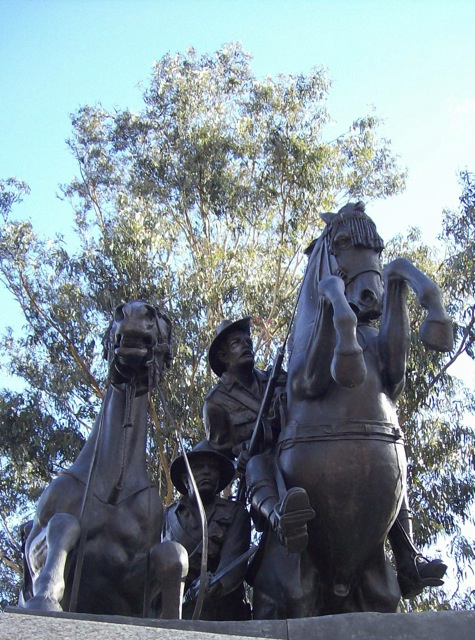
Light Horse Memorial, front.
In fact the fate of the Walers left in Palestine was not as dreadful as it is still portrayed in some books.
The research files at the Australian War Memorial* make it clear that of the approximately 8,700 horses in Palestine when the war concluded, about a third – some 2,700 who were aged over 12 or in an unfit condition – were shot, mostly under veterinary supervision.
But the rest of them were transferred to other Imperial army units – mainly the Indian cavalry, for which the Walers had been bred in the first place since the 1830s.
The horses stayed behind...
It's true that the horses stayed behind. A third of them, aged over 12 or sick, were shot. Two thirds went on to continue living a useful military life.
They were not all killed ... although it is certainly true that Sandy was the only one of them to come home.
Sandy. It’s a good story. I’ll tell it to you in the next article.
* See AWM25 245/112 Disposal of Animals on Demobilisation, especially a cable of 15 January 1919; and AWM25 29/1 Disposal of AIF Animals In Egypt June-August 1919.
Photo credits:
Old Bus Depot Market, Canberra: author photo.
Australian and New Zealand Light Horse Memorial, replica after Web Gilbert, Anzac Parade, Canberra: author photos.
Desert Mounted Corps Memorial to the horses, Sydney.
Steven Holland, Memorial to Animals in War, AWM: author photo.
* * *
Sandy 2
Poor old Sandy...
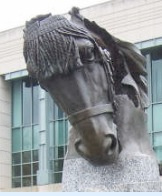 He was the favourite charger of General Bridges, who commanded the 1st Australian Division when the Great War broke out in 1914.
He was the favourite charger of General Bridges, who commanded the 1st Australian Division when the Great War broke out in 1914.
Sandy didn't look perhaps the most dashing of the officers' charges. But he had an equanimity – a stoic, gentle temperament, that appealed greatly to the General.
It's a matter of record that Bridges was killed at Gallipoli in May 1915, and was the only Australian soldier to be brought home from the First World War for burial.
Bronze sculpture, Sandy's head, Web Gilbert, AWM.
He lies on Mount Pleasant behind Royal Military College Duntroon, in Canberra, where he was also the first commandant.
It's sometimes said that Sandy marched in the General's funeral procession carrying his master's upturned boots in his stirrups, but that's not so. He was still with the horses in Egypt, and later went with the veterinary section to France, where he remained for most of the war.
Only towards the end of the conflict was it decided also to bring Sandy home. In fact, he arrived just at the time of the Armistice in November 1918, and was to have gone to Duntroon, to be near Bridges.
In the end, however, Sandy stayed at the remount depot in Melbourne where he lived until 1923, when he had to be put down at the age of about 15.
Five hooves
There’s some rather gruesome correspondence on the files at the Australian War Memorial (AWM) debating what to do with Sandy after he'd been destroyed.
Would they send him to the taxidermist? And if so would they preserve the whole body or just the head? What were the costs? Who would pay? And where would he be put?
Only his head was stuffed, ultimately. It was mounted in a glass case and displayed at the AWM – where it is still in storage, a little tired and worn now, but Sandy still comes out occasionally for special exhibitions.
There's a photo of it in my book Animal Heroes (page 67). They also made paperweights out of his hooves, mounted with silver plates and suitably engraved, which were presented as trophies to senior defence officials.
Strange to say, at one time apparently there were five of them!
Bronze memorial
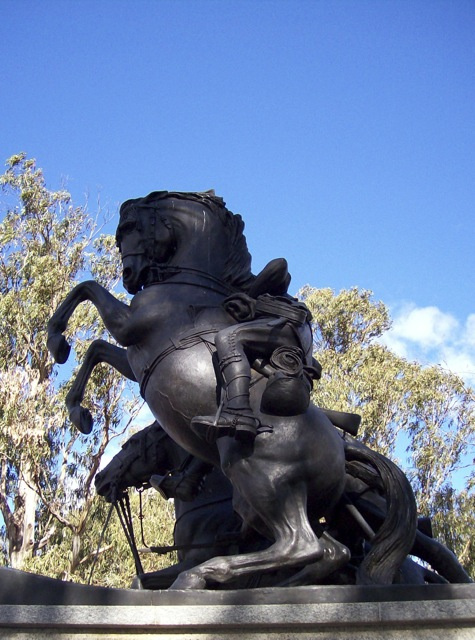
Light Horse Memorial, after Web Gilbert, Canberra
As I mentioned in the last article, Sandy's head was also used as the model for one of two horses (the other was a New Zealand mare called Bess) in a large bronze group sculpture by Web Gilbert to commemorate the Light Horse, erected in Egypt until it was blown up during the Suez crisis of 1956.
Bits of it were rescued however, including Sandy's head (the rearing horse), and he was brought back home for a second time.
Replicas of the sculpture can be seen in Canberra's Anzac Parade and at Albany in Western Australia (whence the first contingent sailed to war in 1914).
Evocation
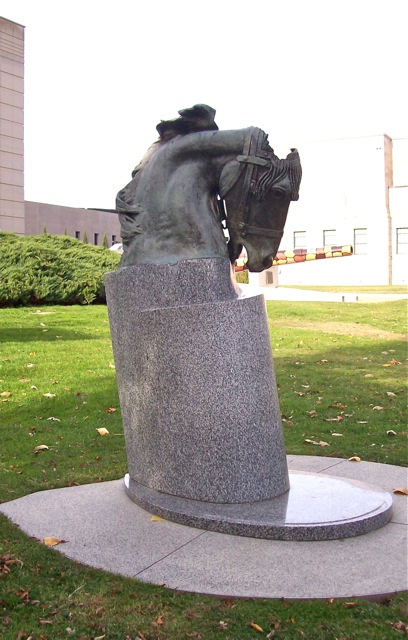 However, Sandy's original bronze head was used by my friend Steven Holland as the centrepiece of a memorial he created to all animals who’ve served in war, now in the sculpture garden at the AWM.
However, Sandy's original bronze head was used by my friend Steven Holland as the centrepiece of a memorial he created to all animals who’ve served in war, now in the sculpture garden at the AWM.
Steven Holland, Memorial to Animals in War, AWM.
It stands on a plinth, terminating in a shaped base that might represent a horse's eye, or a human tear.
A shallow groove allows rainwater to trickle down and collect for birds and small dogs to drink.
But the thing is Sandy's head. It is so very evocative of the heroism and also the horrors of war.
Stand at the front, and there are all those noble qualities reflected of which Henry Gullett wrote.
Walk round to the rear, and you'll see that the whole back of the head has been blown apart in that Suez blast – the metal ripped, and jagged, and terrifying.
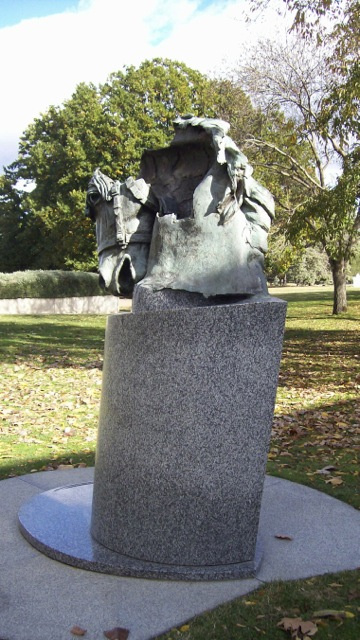
I told the woman at my market stall that she should go and see it. I hope she did.
It's outside, not far from the big railway gun captured near Amiens in 1918.
Sandy's head: another view
In fact I hope everyone who goes to the War Memorial steps across the grass a moment to see Sandy's head.
Not just for the horse himself, but more importantly for what he represents.
In all of us.

